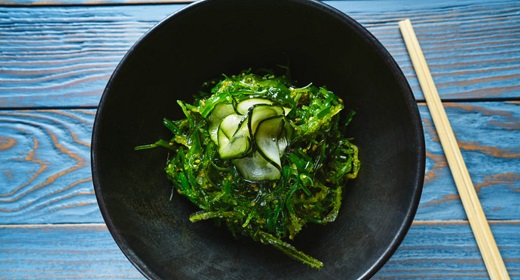by Jill de Jong: News flash: Seaweed is really good for you. Here’s why—and how—you should add nutritious seaweed to your diet today…
Seaweed Is Good for You
A staple in Asian cuisine, seaweed (algae that grows in the ocean) is not yet a kitchen staple in America. But most of us are familiar with blue-green algae such as spirulina and chlorella—and, our most consumed seaweed, nori, which is what covers your beloved sushi roll.
Also dubbed sea vegetable, seaweed comes in three types: brown algae, green algae, and red algae—each with its own characteristics. A precious food source for ocean life, seaweed offers an unmatched nutrition profile for humans as well.
Three Reasons to Add Seaweed to Your Diet
1. It is full of minerals. The mineral content of seaweed is 10 times greater than that of soil-grown plants. Its primary mineral components are iodine, calcium, phosphorus, magnesium, iron, sodium, and potassium. In addition, marine algae contain a wide range of important trace elements such as zinc, copper, manganese, and selenium, as well as vitamins A, B, C, and E.
2. It is rich in iodine. Iodine deficiency is common. Used by the thyroid gland to regulate metabolism, iodine is necessary for overall health. Seaweed is one of the best food sources of iodine. Kombu (dried seaweed) is highest in iodine content, followed by wakame and nori. You only need to eat small amounts for health benefits—you can have too much of a good thing (while too little iodine can cause thyroid problems, so, too, can excess). U.S. adults are advised to get a minimum 150 micrograms of iodine daily; pregnant women should get 220 micrograms. (If you are taking thyroid medications, you should talk to your doctor before adding seaweed to your diet.)
3. It is good for your digestive health. Consuming algae provides the body with gut-healthy prebiotic fiber, and a class of carbohydrates found in seaweed called polysaccharides has been shown to increase the growth of “good” bacteria. Cooking beans with kombu makes them easier to digest and less gas-producing.
Simple Seaweed Snacks to Get Your Daily Dose
Seaweed is quite versatile. It can be sprinkled on Buddha bowls; used in soups, salads, and smoothies; or taken as a supplement. Some seaweed blends can be a great substitute for salt. You can also substitute a tortilla with a large sheet of dried nori to make a wrap. Here are three simple ways to up your seaweed intake:
1. Gimme Roasted-brand seaweed snack. A satisfying crunchy snack, these tasty lightly oiled, salty sheets melt on your tongue.
2. Teatis Tea-brand drinks. With flavors like matcha mint and turmeric ginger, you won’t taste the seaweed, but you will reap the health benefits of it being a main ingredient.
3. Dulse flakes. Made by many companies, these flakes are great for salads, soups, and stir-fries, or to add to your smoothie.










































